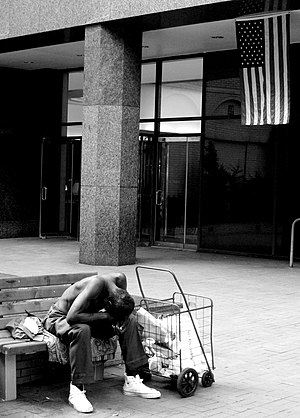
English: A homeless man in New York with the American flag in the background. Français : Un homme sans domicile fixe à New York. Un drapeau des États-Unis est visible en arrière plan. (Photo credit: Wikipedia)
The National Center on Family Homelessness (NCFH) reports that U.S. family homelessness rose by 38% from 2007 to 2010.
A more recent Point-in-Time Count conducted by the U.S. Interagency Council on Homelessness (USICH) found that on a night in January 2012 families containing 239,403 persons (an estimated 77,157 households) were homeless That number was up 1.4%, over 2011.The Department of Education reports that nearly 1,065,794 public school children were identified as homeless over the course of the 2010-2011 school year (the highest number on record).
Currently the U.S has a shortage of 6.8 million affordable housing units. USICH believes that the most common reasons for families becoming homeless are the inability to find stable housing, loss of a job or doing work that doesn’t pay enough to afford housing, health crises, domestic violence, having children at a young age and lack of a strong social support network.
A report from NCFH states: Without a place to call home, children are challenged by unpredictability, insecurity and chaos. Families experiencing homelessness are vulnerable; most have experienced extreme poverty, residential instability and violence; and many parents have limited education and work histories.
Often, families who are homeless have experienced ongoing trauma in the form of childhood abuse and domestic and community violence, as well as the traumas associated with poverty and the loss of home, safety and sense of security.
These experiences can significantly impact how children and adults think, feel, behave, relate to others and cope. A constant barrage of stressful and traumatic experiences can have profound effects on a child’s development and his/her ability to learn, ultimately affecting success in life.
In June 2010, USICH released a Federal Strategic Plan to Prevent and End Homelessness, which claimed that adequate funding, political will and commitment at all levels of government could end family homelessness by 2020.
The multi-faceted strategy to accomplish this involves: 1) supporting federal homeless programs, 2) utilizing programs that help children and youths thrive; 3) supporting veterans and their families; 4) reducing and preventing domestic violence and protecting survivors; 5) initiating and supporting trauma-informed care; 6) investing in data collection; and 7) developing best practices.
Reverend Bobbi Virta, of the 44-member Interfaith Coalition on Homelessness in Whatcom County, WA, reports that a 2012 Point-in-Time Count found that 22% of the homeless in her community were younger than 18.
She says:
Homeless families are often doubled-up, moving from one friend’s house to the next. They are sleeping in cars or camping outside. Some are lucky enough to get a voucher for an occasional night in a cheap motel for the chance to shower. Parents are struggling to keep it together, and children are struggling to stay in school.
Although many group shelters separate fathers and boys older than 12 from mothers and daughters, her Coalition’s nine temporary/emergency housing facilities allow families to stay together. She reports that after three months of emergency housing, 90% of the homeless residents leave for stable, long-term housing.
Related articles














